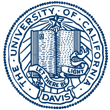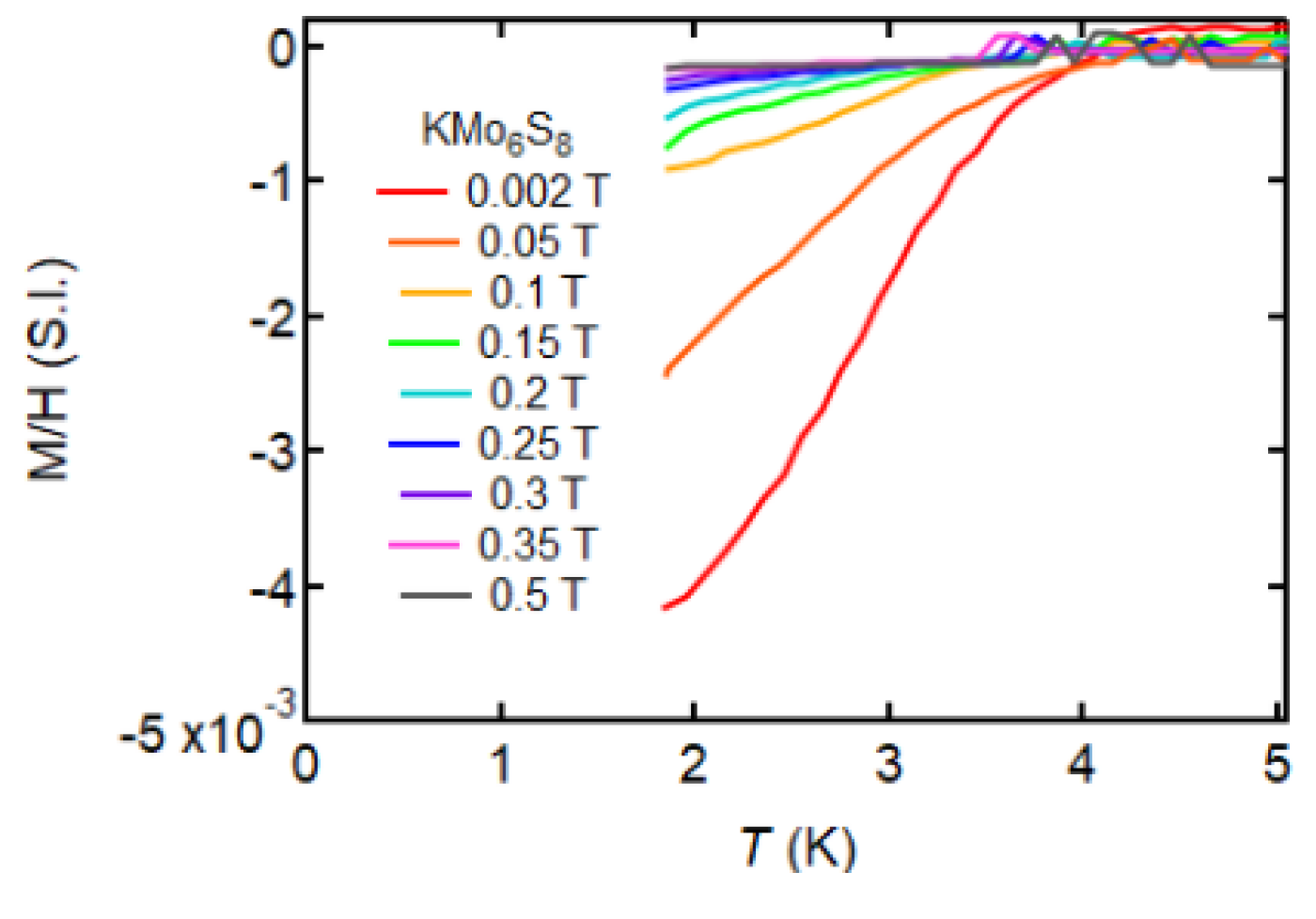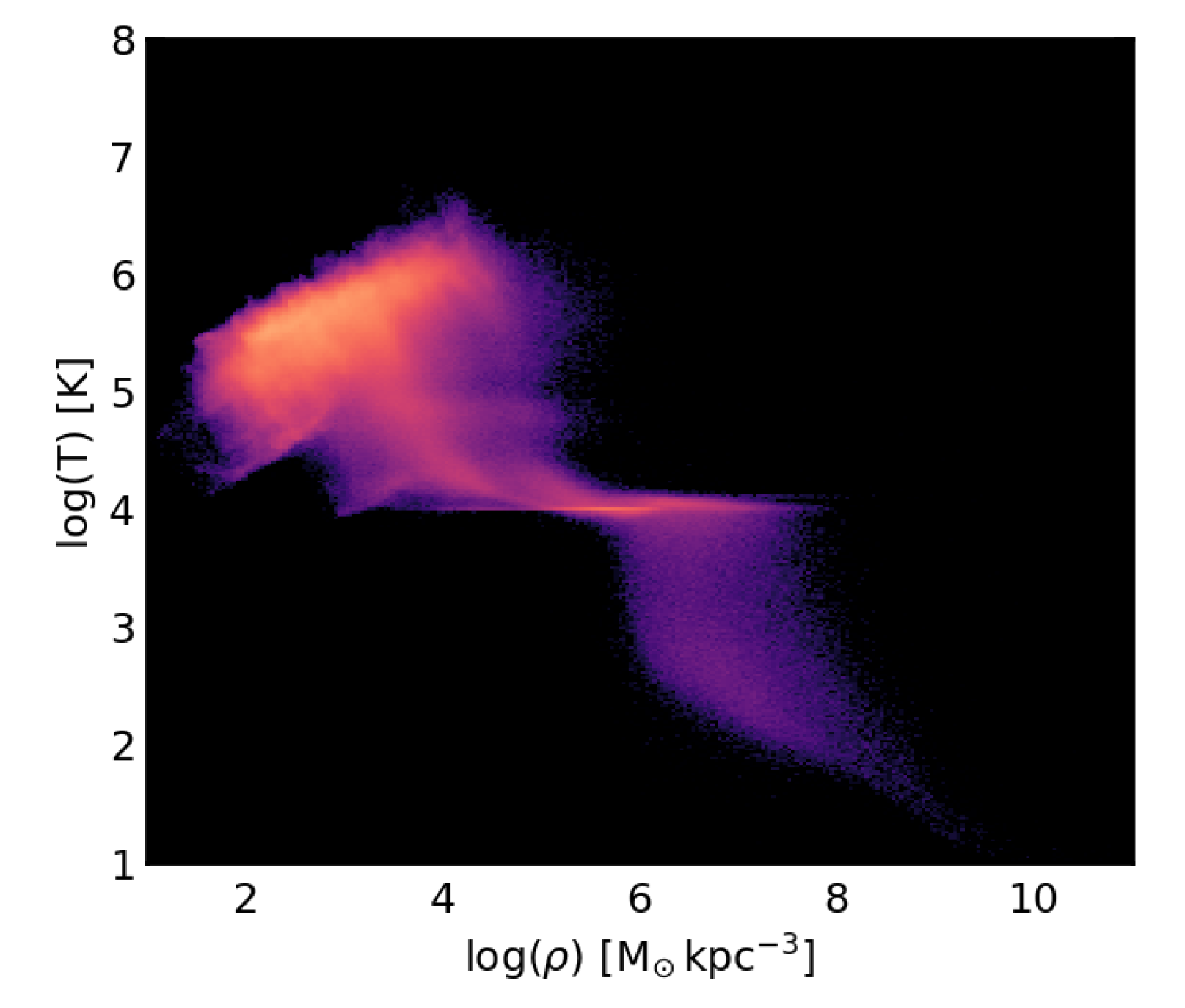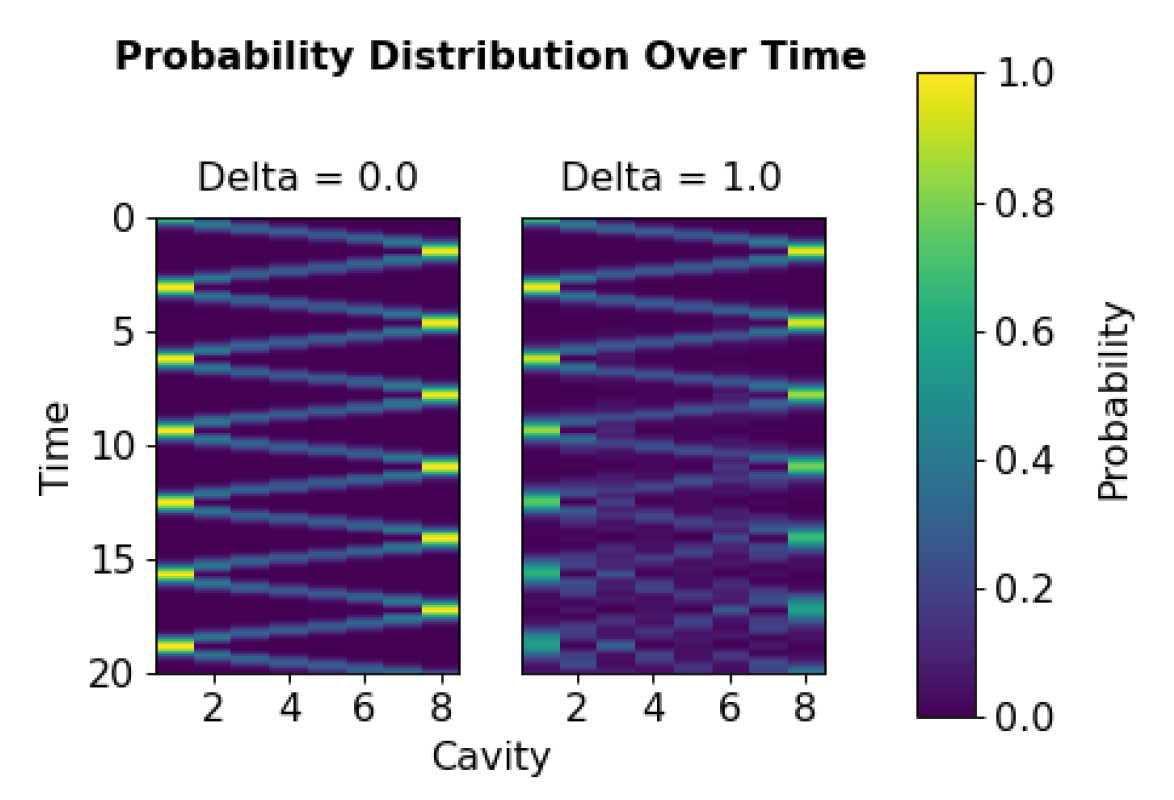
This REU program was funded through NSF PHY-1852581.

Magnetic susceptibility curves at different fields for KMo6S8. The drop at low temperatures in the low-field curves indicates superconductivity, which is destroyed by a sufficiently large magnetic field. (See Lexy Gillette's paper to learn more.)
Students' names link to their final papers. Advisors' names link to the research group web pages.
Particle Experiment
Raul Garrido Garcia (Purdue University Northwest; advisor Eric Prebys) studied the conversion of muons to electrons to test for physics beyond the Standard Model of particle physics. A muon can be captured by a nucleus, and normally this occurs through the weak interaction, in which a proton changes to a neutron and a neutrino is emitted. It is possible, however, that in certain scenarios a muon interacting with a nucleus could convert to an electron, albeit with very low probability. Fortunately it is possible to test this rate at which these two processes occur at Fermilab, which is an important benchmark for theory. Raul carried out several analyses of the behavior of a beam of slow muons that is produced by colliding protons with a tungsten target.
Jesse Mendez (Humboldt State University; advisor Bob Svoboda) worked on developing a water-based liquid scintillation device for neutrino detection. Traditional liquid scintillators for neutrino experiments utilize several tons of organic liquids, but a water-based liquid scintillator, employing both organic liquid encapsulated by surfactant molecules for form micelles, offer greater sensitivity and efficiency. A challenge for such detectors, however, is contamination by impurities dissolved in the water, requiring sophisticated filtering techniques. Jesse tested various filtering approaches by measuring the UV absorption of Gd in solution.
Nuclear Experiment
Miles Cochran-Branson (Lawrence University; advisors Daniel Cebra and Manuel Calderon de la Barca Sanchez) studied the production of b-bbar and c-cbar mesons in lead-lead nuclear collisions at the Large Hadron Collider and the Relativistic Heavy Ion Collider. Such processes create a plasma of quarks and gluons, which decay into different hadrons, but these particular mesons are expected to be suppressed. The collisions were simulated using Monte Carlo techniques, a Glauber model for the distribution of nucleons, and known models for particle production. The probabilities for production of these mesons were estimated that can be compared with experiments currently underway.

Display of an event for a 2H-197Au collision at 200 GeV. Each line or curve corresponds to a particle, with the color related to the particle's charge.
Nuclear collisions between deuterium and gold nuclei were also studied in order to study the properties of a quark gluon plasma. In this case, the nuclei must collide as close as possible to "head-on" (a central collision) in order to form the plasma. Adam Dockery (Michigan State University; advisors Daniel Cebra and Manuel Calderon de la Barca Sanchez) used Monte Carlo Glauber simulations to study these collisions in order to compare with observations of the particle multiplicity distributions. He found that a new Hulthen form of the deuteron wavefunction worked best to fit the observed data.
Astrophysics
Galaxy cluster mergers may reveal important information about the distribution of dark matter in the universe. Patrick O'Mullan (Worcester Polytechnic Institute; advisor David Wittman) investigated the radio shockwaves that result from these interactions, which can be observed via telescopes. He utilized a large scale cosmological simulation that incorporates dark matter, and studied the geometry and polarization of the emitted light relative to the incoming and outgoing clusters.

Phase diagram of halo gas showing the temperature versus mass density of individual gas particles from a simulation of a Milky Way-type galaxy.
Bhavya Pardasani (University of Illinois, Urbana-Champaign; advisor Andrew Wetzel) studied the interactions of galaxies and the gaseous halos that surround them using large scale simulation data. A number of large galaxies in the universe interact with smaller satellite galaxies nearby that are gravitationally bound. The host galaxy tends to strip off the gas from the satellites. She analyzed 14 galaxies that are similar to the Milky Way that were simulated via hydrodynamic equations involving gas, star and dark matter particles. She studied the distribution of gas and its temperature as a function of position relative to the host galaxy, which will be useful to understand the results of observational surveys of the universe.
Condensed Matter Theory
The theory of the transverse field Ising model was investigated by Jessica Jiang (Smith College; advisor Rajiv Singh). The Ising model is commonly used as a model system for a phase transition, and consists of a lattice of spin 1/2 objects that experience a nearest neighbor coupling. At low temperatures, the spins will spontaneously align either all up or all down below the Curie temperature. If one applied a magnetic field that is perpendicular to the spin coupling direction, though, then quantum fluctuations will prevent the system from ordering ferromagnetically, and there is a quantum critical point associated with a T=0 phase transition. Jessica used exact diagonalization and numerical linked-cluster methods to study this model for the checkerboard lattice, which is magnetically frustrated. She computed several key properties, such as the magnetization and entropy, as a function of model parameters.
Jack Mucciaccio (Coe College; advisor Richard Scalettar) studied quantum state transfer, an important phenomenon that is important for quantum information technology. One can ask how a quantum state on a localized qubit, for example a color center, could be transmitted to another physical location. A promising approach is to use photons in a coupled cavity array. This system can be modeled by the Tavis-Cummings-Hubbard model, characterized by a set of coupled optical cavities along a linear array. Jack solved the Schrodinger equation for this array and studied how a state localized on one side of array can move to the other side over time. He also investigated how disorder would alter the probability distributions.

Heatmap of time vs. cavity index. The color represents the probability of an excitement in that cavity.
Condensed Matter Experiment
Eric Beery (Haverford College; advisor Dong Yu) investigated nanocrystals of lead perovskite for potential photovoltaic applications. Crystals were synthesized and then the induced photocurrent was measured with circularly polarized light under cryogenic conditions. The current depended strongly on the orientation of the polarization, revealing important information about the spin-orbit coupling through the Rashba splitting of the electronic bands.
Lexy Gillette (Westmont College; advisor Valentin Taufour) studied the magnetic properties of several Chevrel phase materials as a function of temperature. These materials belong to the same structural family, and have the empirical formla MxMo6X8. Here X can be S, Se, or Te, M is a metal, and x can vary up to 4, depending on the charge state of the metal ion. Several of these materials are superconducting, with properties comparable to the best superconductors used in commercial magnets. Alexis grew five new Chevrel materials, and discovered traces of superconductivity in KMo6S8, and ferromagnetic behavior in CrMo6Te8.
Tianna Green (Wellesley College; advisor Nicholas Curro) studied the material TmVO4 using nuclear magnetic resonance (NMR). The V-51 isotope has spin 7/2, and has seven independent resonances in a magnetic field. TmVO4 exhibits ferroquadrupolar order at low temperatures, but it can be continuously suppressed to a quantum phase transition by applying a magnetic field along the crystalline c-axis. This makes it a model system for the transverse field Ising model. Tianna measured the nuclear spin relaxation rate as a function of temperature and field to study this behavior.
Neutron stars are among the most fascinating astronomical bodies, and are believed to exhibit superfluidity within their cores. Although such phenomena cannot be studied directly, it is possible to study superfluidity of helium in terrestrial laboratories. Emily Padula (Colby College; advisor Rena Zieve) worked on a project to measure the behavior of rotating superfluid helium. When superfluid vortices become unpinned, they can create a glitch that may be observed either in the pulsar timing of a neutron star, or in the rotation of a spherical flask of rotating liquid helium. Emily developed an optical system for measuring the rotation rate with high precision for this experiment.

Fermi surface dichroism map of the magnetic Weyl semimetal Co3Sn2S2. A threefold rotation symmetry is imposed.
Daniel Shulman (University of California, Berkeley; advisor Inna Vishik) used angle-resolved photoemission spectroscopy (ARPES) to study a magnetic Weyl semimetal, Co3Sn2S2. This electrons in this material exhibit unusual topological properties, and their dynamics can be described by the Weyl equation. These unusual topological properties emerge in the presence of magnetic order which breaks time-reversal symmetry, and give rise to unusual spin phenomena such as an anomalous Hall effect. To study the electronic structure, ARPES experiments direct photons to the surface of a crystal and measure the energy and momenta of the emitted electrons. In these experiments, the incoming light was circularly polarized, which provided deeper insight into the spin-dependent band structure of this unusual material.
Marissa Singh (Pitzer College; advisor Rena Zieve) developed image processing algorithms to study the stability of a granular system. When a system of loose material is tipped, it can undergo sudden avalanches that can be hard to understand and predict. To better understand and measure the forces within these systems and the dynamics of the avalanches, Marissa used an apparatus containing a 2D mixture of dimers and hexagonal particles that can be carefully rotated and optically recorded. She developed algorithms to identify the position of each particle from the recorded footage in order to analyze the statistics of many hundreds of avalanches. Her algorithm dramatically improved the efficiency and accuracy of the experiment and will enable detailed analyses in the future.